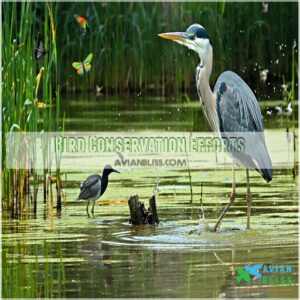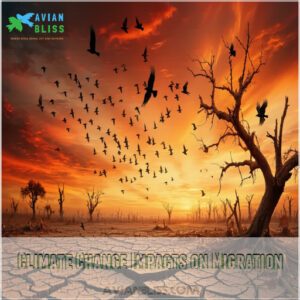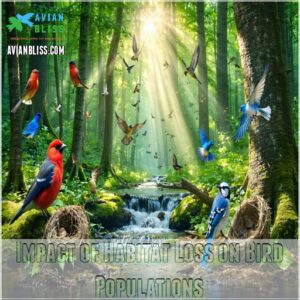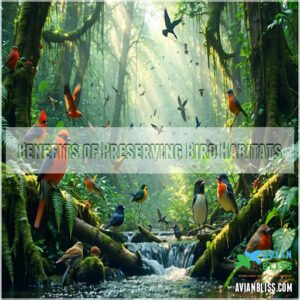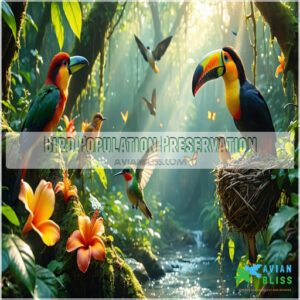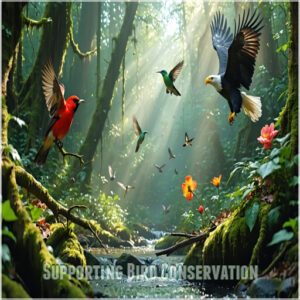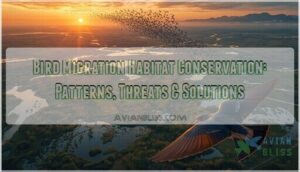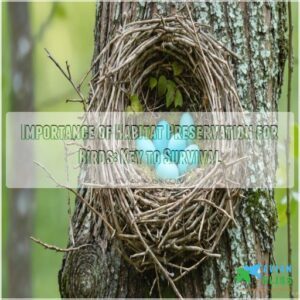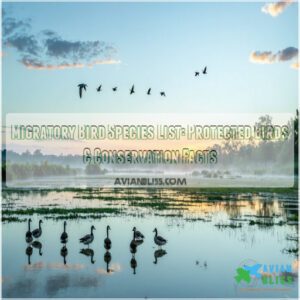This site is supported by our readers. We may earn a commission, at no cost to you, if you purchase through links.
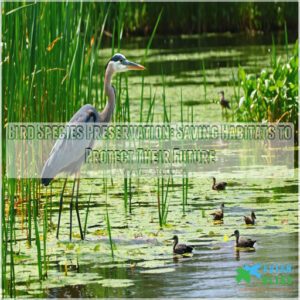
Restoring wetlands and protecting forests provide birds with the nesting and migration spaces they need.
Acts like the Migratory Bird Treaty Act safeguard over 1,000 species, ensuring their survival despite challenges like habitat loss, climate change, and invasive predators.
You can pitch in by supporting native plant gardens, reducing pesticide use, or joining bird counts to aid research.
Even simple changes, like cleaner water and reduced plastic waste, make a difference.
Every step helps, because healthier ecosystems mean healthier environments—for you, me, and every living thing.
Table Of Contents
- Key Takeaways
- Bird Conservation Efforts
- Threats to Bird Species
- Importance of Bird Habitats
- Bird Population Preservation
- Supporting Bird Conservation
- Frequently Asked Questions (FAQs)
- What is the #1 most endangered bird?
- What is the best charity for bird conservation?
- What is an example of bird conservation?
- How can invasive species affect native bird populations?
- What are effective ways to combat illegal bird trade?
- How does deforestation impact breeding success in birds?
- What role do wetlands play in bird migration?
- How can schools promote bird conservation awareness?
- Conclusion
Key Takeaways
- Support bird conservation by restoring habitats like wetlands and forests, planting native gardens, and reducing pesticide use.
- Laws like the Migratory Bird Treaty Act protect over 1,000 bird species by preserving habitats and cracking down on harmful activities.
- Climate change, invasive species, and pollution threaten birds; small actions like reducing waste and advocating for stricter regulations can help.
- Join bird counts or community science projects to contribute to research and better conservation strategies.
Bird Conservation Efforts
You play a vital role in bird conservation by supporting efforts like habitat restoration, urban bird treaties, and grants for wetland protection.
These initiatives, backed by laws like the Migratory Bird Treaty Act, guarantee birds have safe spaces to thrive.
Migratory Bird Treaty Act
The Migratory Bird Treaty Act (MBTA) is a cornerstone of bird species preservation, safeguarding over 1,000 migratory bird species.
It enforces conservation laws, protecting bird migration patterns and habitats.
By cracking down on harmful activities, the MBTA guarantees habitat preservation while boosting conservation funding.
It’s like a safety net, keeping migratory birds thriving for future generations.
Habitat Conservation Initiatives
Habitat conservation ensures birds thrive in a changing world. Efforts focus on sustainable, impactful strategies.
- Wetland Restoration: Revive essential water ecosystems for migratory birds.
- Forest Preservation: Safeguard nesting spots and shelter. Understanding bird habitat essentials is essential for effective conservation.
- Ecosystem Services: Support biodiversity’s natural balance.
- Conservation Planning: Map critical habitats for lasting impact.
- Community Action: Empower locals, fight habitat fragmentation.
Together, we secure birds’ futures.
NAWCA Grants for Wetland Restoration
Thanks to NAWCA grants, wetland restoration becomes a powerful tool for saving bird habitats.
These funds support restoration techniques like improving water quality, mapping wetland ecosystems, and creating thriving migratory bird habitats.
By backing habitat restoration efforts, this grant funding guarantees bird species preservation, safeguarding wetlands for both birds and humans.
It’s proof that a little funding can go a long way!
NMBCA Grants for Neotropical Bird Conservation
NMBCA grants are a lifeline for Neotropical Bird Conservation, channeling funding into impactful bird conservation efforts.
These grants support:
- Species Research: Tracking migratory routes for better conservation strategies.
- Habitat Restoration: Reviving critical stopovers for survival.
- Conservation Strategies: Tackling threats like deforestation.
- Conservation Investments: Assisting local projects in preserving bird species.
Every dollar advances bird species preservation and ecosystem health.
Urban Bird Treaty for Urban Habitats
Cities don’t just belong to people—they’re home to birds, too.
The Urban Bird Treaty helps create bird-friendly cities by weaving urban planning with habitat restoration, boosting urban green spaces for bird conservation efforts.
From preserving urban bird habitats to enriching city wildlife, this initiative guarantees cities support both humans and birds.
It’s a win for bird species preservation and your neighborhood’s charm!
Threats to Bird Species
You might be surprised how many threats birds face every day, from losing their habitats to harmful human activity.
Climate change, invasive species, and pollution all play a role in making survival harder for these remarkable creatures, facing climate change.
Habitat Loss and Fragmentation
When forests shrink or break apart, birds lose essential spaces to feed, breed, and rest.
Deforestation impacts ripple through ecosystems, causing fragmentation effects that isolate populations. Land degradation doesn’t help—it strips resources and leaves bare ground.
Protecting these essential stopover sites is important for migrating birds, as highlighted on the bird migration habitat conservation webpage.
Here’s what happens:
- Habitats vanish fast.
- Wildlife corridors disappear.
- Ecosystem disruption grows.
- Bird habitat restoration becomes important.
Every bit of habitat matters.
Climate Change Impacts on Migration
Climate change messes with bird migration patterns big time.
Temperature shifts and extreme weather throw off migration routes, while sea level rise wipes out key stopovers.
Birds can’t adapt fast enough, leading to ecosystem disruption.
Habitat loss from these changes leaves migratory bird habitats vulnerable, forcing species to search farther for food and rest—a risky gamble for survival.
Changes in temperature patterns substantially impact the migratory behaviors of various bird species, which is a result of climate change and leads to habitat loss.
Introduced Species and Hunting
Invasive species and hunting wreak havoc on birds.
Rats raid nests, feral cats hunt endangered bird species, and the exotic pet trade spreads harm.
You can help:
- Support feral animal control programs.
- Advocate for stricter hunting regulations.
- Fight wildlife poaching by reporting suspicious activity.
- Push for bird extinction prevention efforts targeting threatened bird species.
Together, we’ll tackle these threats to achieve bird conservation!
Pollution and Human-Caused Bird Deaths
Toxic chemicals and plastic waste harm birds more than you’d think.
Picture a seabird mistaking plastic for food—it’s heartbreaking, isn’t it?
Bird collisions with glass can be mitigated with bird deterrent window film.
Bird collisions with glass and noise pollution from human activity only add to the chaos.
Plus, toxic pesticides poison habitats, and pollution has a ripple effect, making bird extinction prevention harder.
Small changes, like reducing waste, help.
Importance of Bird Habitats
You can’t protect birds without protecting their habitats, which provide essentials like food, shelter, and nesting spaces.
Losing these habitats doesn’t just harm birds—it unravels entire ecosystems that depend on their presence.
Role of Bird Habitats in Ecosystems
Bird habitats are nature’s backstage crew, keeping ecosystems thriving.
They create safe spaces for species interactions, ensuring ecosystem balance.
Bird migration relies on habitat diversity for rest and food, while healthy habitats boost biodiversity and ecological resilience.
Think of it as teamwork—habitats protect birds, birds support the environment, which is crucial for ecosystem balance and biodiversity.
Habitat preservation is your ace in protecting nature’s original symphony.
Impact of Habitat Loss on Bird Populations
Losing habitats slices through bird populations like scissors to a map; it’s messy and devastating.
Habitat destruction and fragmentation leave bird species struggling for food and shelter, this causes species decline and even bird extinction.
To understand the gravity of this issue, learn more about the importance of habitat preservation.
Ecosystem disruption follows as delicate balances crumble, conservation strategies and bird population monitoring are essential to combat habitat loss and protect these feathered wonders.
Benefits of Preserving Bird Habitats
When habitats disappear, you’re not just losing scenery; you’re unraveling the threads of biodiversity.
Preserving bird habitats boosts ecosystem services like insect control and pollination, while maintaining wildlife corridors keeps migrations flowing.
Habitat restoration transforms struggling areas into biodiversity hotspots, supporting ecological balance.
By investing in habitat preservation, you’re protecting bird species and creating stronger, healthier ecosystems for everyone, which is essential for maintaining ecological balance.
Carbon Storage and Sequestration
Preserving bird habitats doesn’t just help wildlife—it’s a win for the planet too.
Healthy forests and wetlands act as powerful carbon sinks, trapping greenhouse gases and supporting ecosystem health.
Here’s how they make a difference:
- Forest regeneration captures carbon naturally.
- Wetlands store greenhouse gases in their soil.
- Soil conservation reduces erosion.
- These habitats boost biodiversity and fight climate change.
Support for Biodiversity
A thriving planet depends on species diversity—think of it like a Jenga tower.
Remove too many pieces, and everything tumbles.
Healthy bird habitats boost ecosystem balance and species protection, safeguarding avian biodiversity.
Here’s how habitats support biodiversity:
| Benefit | Description |
|---|---|
| Ecological Balance | Keeps ecosystems thriving. |
| Species Protection | Shields endangered birds. |
| Ecosystem Services | Pollination, pest control, etc. |
| Wildlife Preservation | Secures diverse species. |
| Biodiversity Conservation | Strengthens habitats. |
Protecting habitats? It’s science’s superhero move.
Bird Population Preservation
You play a vital role in protecting bird populations by supporting efforts like captive breeding, habitat restoration, and sustainable land use.
These actions help maintain biodiversity, giving countless bird species a fighting chance against habitat loss and climate change.
Captive Breeding and Reintroduction
Through breeding programs, species reintroduction helps reverse declines by releasing captive-raised birds into their natural habitats.
Captive management maintains genetic diversity—no inbreeding blues here! Training survival skills before release boosts bird rehabilitation success.
Effective bird breeding programs are vital for maintaining healthy populations.
Wildlife restoration hinges on fixing habitat issues first, while bird rescue and rehabilitation save species on the brink. It’s strategic bird conservation at its finest!
Translocation and Habitat Protection
Sometimes, birds need a little help finding a better home.
That’s where species relocation steps in, moving at-risk birds to safer areas.
Pair that with habitat restoration—like creating wildlife corridors or using ecosystem engineering—and you’ve got a winning combo for bird conservation.
Habitat protection isn’t just good science; it’s a lifeline for bird species preservation and vibrant ecosystems.
Community Engagement and Conservation Efforts
Getting involved in bird conservation isn’t just for the experts—it starts with you.
Volunteer programs and citizen science projects give communities a hands-on role in supporting bird preservation.
Pair that with conservation education and community outreach, and you’ll inspire others to join in.
Environmental stewardship grows when local conservation initiatives build connections, empowering everyone to protect habitats and support bird conservation organizations.
Sustainable Land Use Practices
You’ve seen how community efforts spark change—now take it further with sustainable land use.
Protecting birds means rethinking how we treat the ground beneath us.
Consider incorporating native plant species for a thriving ecosystem, as discussed in these helpful bird habitat preservation tips.
Here’s how you make an impact:
- Practice soil conservation—stop erosion in its tracks.
- Prioritize eco-friendly farming for healthier habitats.
- Manage resources wisely to preserve biodiversity.
- Create green spaces supporting vibrant ecosystem health.
Supporting Bird Conservation
You can play a big part in protecting birds by supporting science-backed conservation efforts and creating safer spaces for them to thrive.
Simple actions like donating to organizations, joining bird counts, or reducing waste at home help protect these fascinating species for future generations, which is a key aspect of protecting birds.
Donations for Evidence-Backed Conservation
Supporting bird species preservation isn’t just about love for nature; it’s about strategic conservation funding.
Donations fuel evidence-based projects, from research grants to impactful conservation investments.
Philanthropy impacts bird conservation research by driving innovation and safeguarding species.
Use smart donation strategies—every dollar can empower conservation funding models that protect habitats and guarantee species preservation.
It’s help that flies high.
BirdLife International and Global Conservation
When you’re supporting bird species preservation, BirdLife International leads the charge.
They connect global partnerships, monitor species, and shape conservation policy that protects nature worldwide.
Their international cooperation powers groundbreaking bird research and drives conservation efforts.
Think of them as nature’s ultimate ally, keeping birds safe through innovative strategies and a shared commitment to our planet’s biodiversity.
By understanding bird conservation methods, individuals can make a significant impact on the preservation of bird species and their habitats.
Annual Bird Counts and Community Science
Annual bird counts and community science projects aren’t just birdwatching–they’re data powerhouses for conservation research.
Your involvement helps species tracking and conservation efforts soar.
Here’s how:
- Bird Surveys: Contribute to tracking migration patterns.
- Citizen Science: Join projects like eBird to log sightings.
- Data Analysis: Your input refines strategies for bird species preservation.
Every tally counts; you’re part of something big.
Creating Bird-Friendly Habitats and Reducing Waste
Create bird-friendly spaces by planting native species and embracing sustainable gardening.
Use bird-friendly products like window decals to prevent collisions and feeders with proper bird feeding tips.
You can find a variety of bird feeders online.
Green infrastructure, like rain gardens, supports habitat preservation.
Embrace eco-friendly products and waste reduction strategies—say no to plastics.
Every step, from bird habitat restoration to reducing waste, boosts bird conservation efforts!
Frequently Asked Questions (FAQs)
What is the #1 most endangered bird?
Imagine hearing a song that might never be sung again—Hawaiian honeycreepers like the Kiwikiu face extinction due to habitat loss and avian diseases.
Protecting them is urgent; every small effort helps preserve their future.
What is the best charity for bird conservation?
Audubon Society stands out for bird conservation, funding essential habitat projects, research, and education.
Their community-driven programs make a real impact—you can jump in and help protect birds while learning some cool facts along the way, which is part of community-driven efforts.
What is an example of bird conservation?
Protecting habitats is key, like restoring wetlands through the North American Waterfowl Management Plan.
You’d safeguard migratory routes, boost food sources, and give birds safe nesting zones, balancing ecosystems and our shared environment.
How can invasive species affect native bird populations?
Invasive species can mess up native bird populations by eating their eggs, outcompeting them for food, and destroying habitats.
They’re like uninvited guests at a party, taking over and leaving the place trashed.
What are effective ways to combat illegal bird trade?
Stop illegal bird trade by supporting stronger wildlife laws, reporting suspicious activities, and avoiding exotic pets.
Promote awareness about the issue and back organizations rescuing trafficked birds.
Every action helps clip the wings of this harmful practice!
How does deforestation impact breeding success in birds?
Imagine trying to raise a family in a house that’s crumbling.
That’s deforestation for birds—destroying nesting spots, food sources, and shelter.
It messes with their survival instincts, slashing breeding success and population growth.
What role do wetlands play in bird migration?
Wetlands are like nature’s pit stops for migratory birds.
They give birds a buffet of food, safe places to rest, and shelter from predators, keeping them fueled and ready for the long journey ahead.
How can schools promote bird conservation awareness?
Picture a "birdwatching garden" at your school—students plant native flowers, track birds, and learn migration patterns.
Pair it with fun workshops on window decals, birdhouses, and reducing plastics to spark conservation passion in everyone.
Conclusion
Think of bird species preservation like maintaining a symphony—each bird plays a key role in nature’s harmony.
By protecting habitats, reducing threats, and supporting conservation efforts, you’re helping keep the ecosystem balanced and vibrant.
Whether through creating native plant gardens, cutting back on pesticides, or joining research initiatives like bird counts, your actions make a difference.
A healthier bird population means a healthier planet, so take small steps today to safeguard their future and ours.

